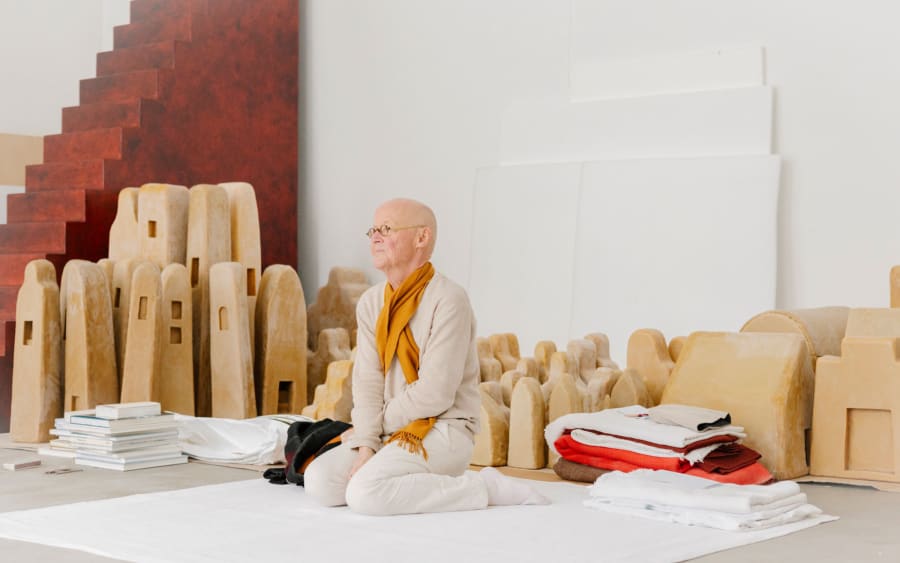The paintings’ motifs run the gamut from hot-button news scenes to the most commonplace things around us: a briefing at the border between Poland and Belarus, portraits of Hungarian Prime Minister Viktor Orbán and of far-right French politician Marine le Pen. Then there’s a vase with flowers, a clock hanging in the artist’s studio, the return home from a New Year’s party. ‘I take everyday things very seriously,’ artist Wilhelm Sasnal explains at a talk at Stedelijk Museum in Amsterdam, where his solo exhibition ‘Painting as Prop’ is currently on view.
The artist draws upon and intertwines references from visual culture, popular culture, everyday life, and (art) history. His predilection toward the quotidian – and its relationship to the political – lies at the core of his practice. With his art, he offers a level playing field on which no object, situation, person, or animal is more valuable than another. A reproduction of an iconic artwork faces a painting of a derelict pig farm in Poland; portraits of political figures hang close to portraits of Sasnal’s wife. The artist inspires surprising mental leaps through clever juxtapositions. ‘Painting is an irresponsible activity,’ he says. ‘How you show your paintings: that’s where the responsibility lies.’ What the artist is trying to convey is that the stories these paintings tell go beyond what’s visible on the canvas. And the white space between one canvas and the next is not empty; it is the carrier of a larger narrative that shifts depending on the viewer.
And what happens when a painting is a prop? It’s a question that Sasnal asks not only as a painter but also as a filmmaker. Born in 1972 in Tarnów, Poland, the artist has produced multiple shorts and features – including, among others, It Looks Pretty from a Distance (2011) and We Haven’t Lost Our Way (2022) – most in collaboration with his wife, Anka. After completing his studies in painting at the Academy of Fine Arts in Kraków in 1999, Sasnal started branching out into photography and graphic novels, as well as ‘repainting’ photographs and appropriating images found in mainstream media and online.
One room on the first floor of the Stedelijk is devoted to 25 recent paintings by the artist. While they are installed here to a design Sasnal conceived specifically for the museum, they were used only recently to dress the set of his film project, The Assistant (2024), which is currently in postproduction. An adaptation of Swiss author Robert Walser’s novel Der Gehülfe (The Assistant, 1908), the film tells the story of Joseph Marti, a drifter hired as an assistant to an inventor named Carl Tobler. Marti quickly assimilates to his new surroundings, but it is precisely this adaptability that, in the end, makes him seem a disposable figure in the lives of others. In the exhibition text, Sasnal points out parallels between Walser’s era and our present times: the world being unaware of the two impending wars (then), and the reluctance to believe similar conflicts could recur (now).
In this exhibition, however, the artist does not linger on his film: he’s far more interested in what these paintings can achieve on their own, liberated from an overarching narrative. Most of the works on view are reproductions of iconic paintings by famous artists, including Georges Braque, Henri Matisse, Pablo Picasso, and Leonardo da Vinci. This is not the first time Sasnal has ‘borrowed’ from other artists – often addressing historical conditions in his own country. In 2001, he extracted and copied details from the graphic novel Maus (1991), in which the author, Art Spiegelman, interviews his Polish-Jewish father about his experiences of the Holocaust. Despite being reproductions, Sasnal’s works are immediately recognizable as his own due to his unique aesthetic: paint is applied thickly to create simultaneously flat yet lively images of landscapes, buildings, objects, and people in a palette that ranges from vibrant colors to monochrome.
One striking connection is between Sasnal’s reproduction of The Green Stripe (1905) by Matisse – in which the French artist depicts his stern-looking wife, Amélie – and two portraits of Sasnal’s own wife, Anka, looking at the gate of the Auschwitz II–Birkenau concentration camp in Poland. In First of January (Back) (2023), she looks straight ahead, while in First of January (Side) (2023), she turns her head to the right to look at the camp. Again, questions linger – how and when do past and present intersect? What have we learned from (art) history?
Here, while Sasnal does not openly comment on past or present political situations in his home country or beyond, there is a palpable sense of contemplation and anxiety. In Poland, Donald Tusk, former President of the European Council and as of 2023 the country’s centrist prime minister, is attempting to reverse the ideological interventions that the previous right-wing government made into the cultural field. Nevertheless, achieving long-term change in the Polish art sector remains difficult. What happens when paintings become props? For Sasnal, they might become quiet witnesses to history, but also open space for us to tell our own stories, too.
Wilhelm Sasnal is represented by Sadie Coles HQ, Foksal Gallery Foundation, Hauser & Wirth, and Anton Kern Gallery.
‘Painting as Prop’ is on view at the Stedelijk Museum, Amsterdam, until September 1, 2024.
Lena van Tijen is a writer, critic, and translator. In 2022, she won the Young Art Critic Prize – an award to encourage young contemporary art writers from the Dutch-Flemish-speaking area.
Caption for top image: Wilhelm Sasnal, Rowers, 2021. © Wilhelm Sasnal. Courtesy of the artist and Sadie Coles HQ, London. Photograph by Andrea Rossetti.
Published on April 10, 2024.


